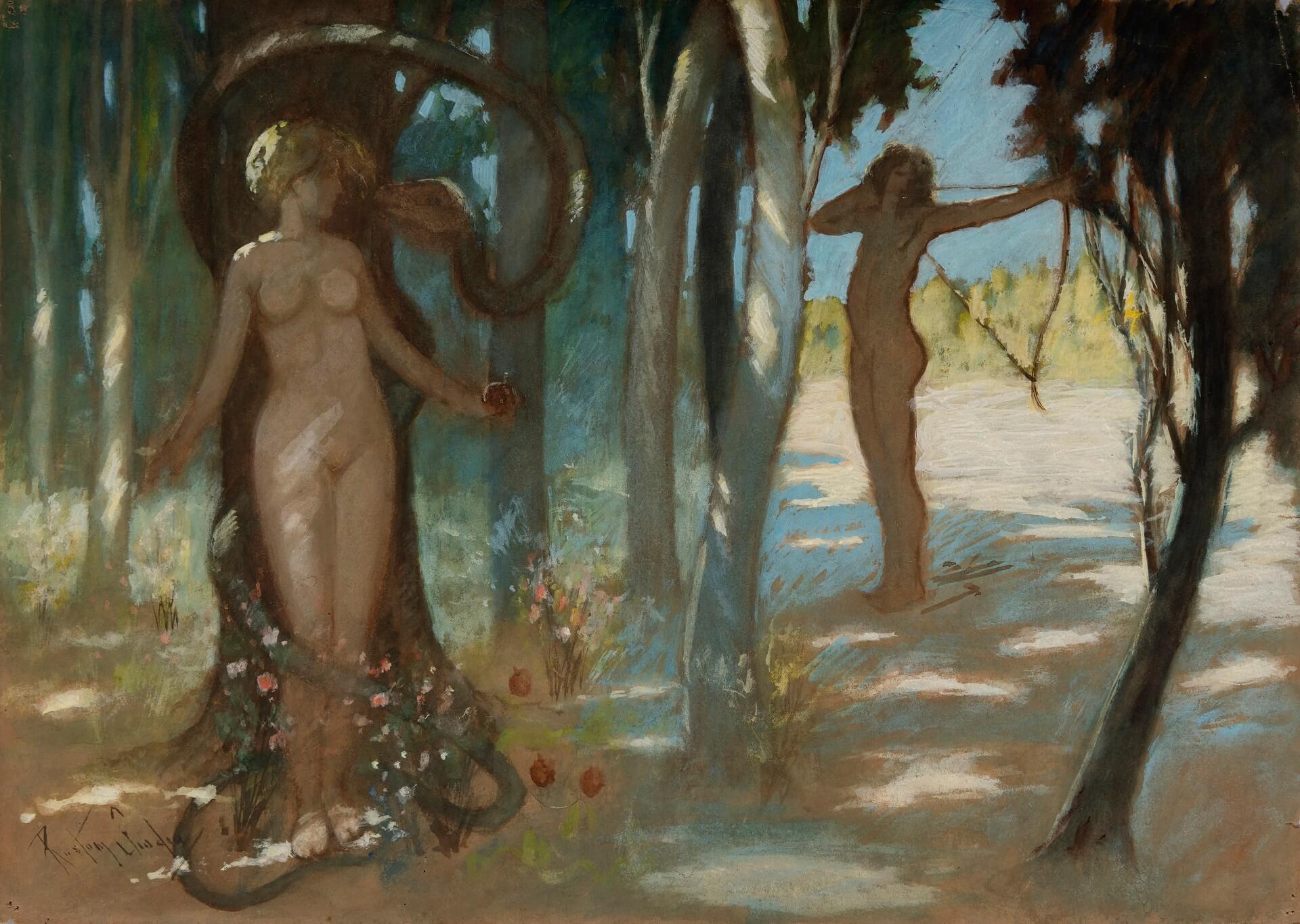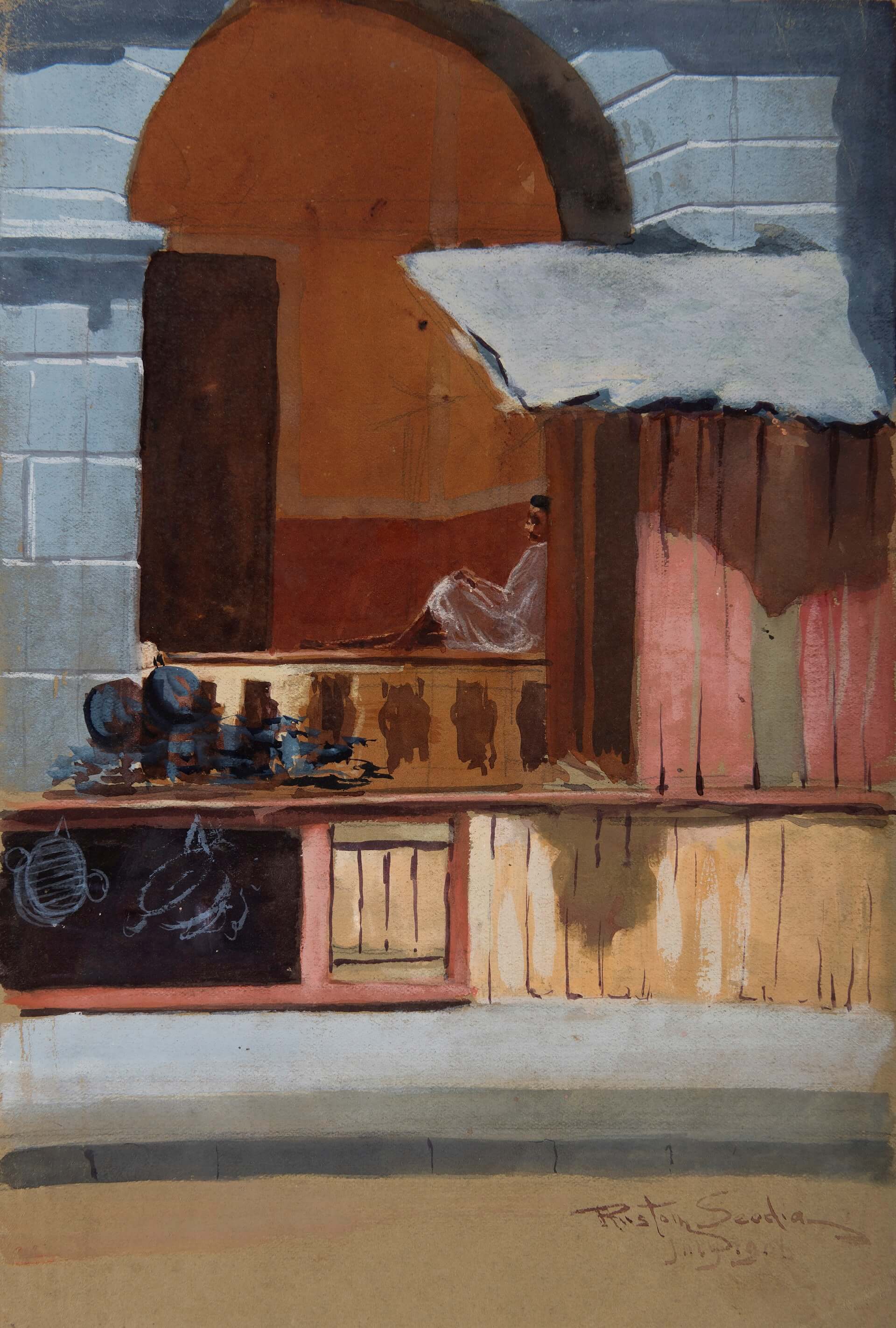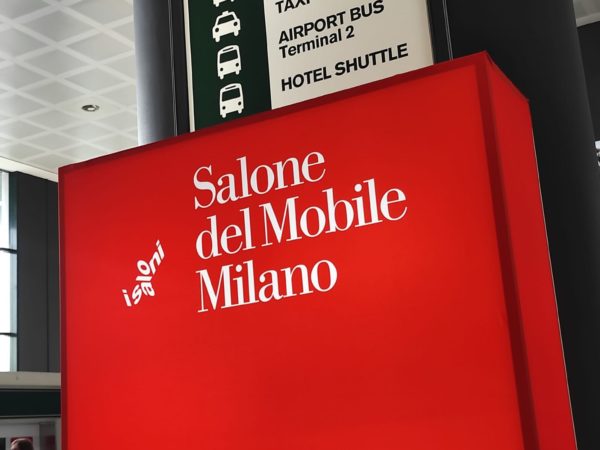Rustom Sisodia’s Retrospective Show Exhibits Realism and Fantasy
 Rustom Sisodia, Untitled (Garden of Eden), 1924 – 1929
Rustom Sisodia, Untitled (Garden of Eden), 1924 – 1929
Rustom Siodia (1881 – 1946) was a painter, illustrator, and essayist. The exhibition at Chatterjee & Lal argues for his place amongst the canon of significant artists working in India during the first half of the 20th Century. Along with M.V. Dhurandar, Siodia can be seen as a successor to Ravi Varma in the lineage of Salon artists who created genuinely original work with a signature style.
Since his death in 1946, this is the first time a major body of Siodia’s work has been displayed. It is a group that charts the entire course of Siodia’s career, from art school at Sir J.J. School of Art, to the peak of his career in the 1930s. Having researched this extraordinary artist for more than a year, Chatterjee & Lal is honoured to be hosting this exhibition.
PERIOD:
STUDENT AT SIR JJ SCHOOL OF ART
Rustom Siodia was born to Parsi parents in 1881. His father had been in the lifelong employ of the famous businessman and philanthropist, Byramjee Jeejeebhoy. Rustom married Hirabai, about whom little is known, in his twenties; their daughter, Cumi, was born in 1907. Cumi would go on to enjoy a successful painting career as an exponent of the Bombay Revivalist style.
The young Siodia studied at Sir J.J. School of Art in the first decade of the 20th Century, during the period that Cecil Burns was Principal. Rustom was later to write that he felt Burns led the School astray from the principles of academic realism, which, to his mind, was the best method of education for an aspiring artist (he disagreed, in particular, with the Santiniketan system of teaching, which had given birth to a school of painting unmoored from the Victorian ideals of Western painting).
 Rustom Sisodia, Untitled (Street Vendor), 1906
Rustom Sisodia, Untitled (Street Vendor), 1906
PERIOD:
STUDENT AT THE ROYAL ACADEMY, LONDON
Between 1908 – 1913, he was enrolled at the Royal Academy, London, and studied under luminaries such as Sir W.B. Richmond, George Storey and John Singer Sargent. He was certainly the first Parsi, as well as being – along with Samuel Fyzee Rahamin – one of the first two Indians ever to study at the prestigious art institute. Studying and living in London made a large impact on Siodia and he ended his student years armed with recommendations and positive newspaper reviews for works submitted in exhibition. The artist would later return to London on several occasions; indeed, it is most likely that the tumult of the Second World War left Siodia unable to return to India during his last trip to Great Britain. He died and was buried in London in 1946.
PERIOD:
1922 – 1925: AJANTA AND ELLORA
Between 1922 and 1925, Siodia undertook a series of vibrant watercolours depicting the early Hindu and Buddhist temples of Ajanta and Ellora. What is most striking about these works is the manner in which the artist has recast ancient Indian sites as quasi-Achaemenid architectural structures. The viewer seems to be asked to recall the great ceremonial capital of Persepolis. Using his academic realist training, Siodia’s enjoyment of history and legend takes wing from this point on in his career. Not only in his art, but also in his writing and illustrations, Siodia seemed to be striving towards an aesthetic celebrating the cultural heights of pre-modern Persia. It is from this period that he begins his illustrated manuscript, “Legends of Ancient Persia”.
It is important to note that Siodia does not depict the frescoes of Ajanta in his paintings. The cave temples of Ajanta were re-discovered in the early 19th Century and their astonishing frescoes, coupled with the site’s proximity to Bombay, encouraged the JJ School of Art to send generations of students to the caves to study and copy the works of art. The stylistic features of the frescoes were to be a major influence in the awakening of the Bombay Revival School of painting in the early 1920s. Indeed, it was Cumi, Rustom’s daughter, who, from the 1930s onwards, would become a leading exponent of this syncretic art movement. Siodia, however, was never a part of the Revivalist cohort even though he had great regard for one of its main proponents: Capt. Gladstone Solomon, principal of the JJ School of Art from 1918 onwards.
 Rustom Sisodia, Untitled (Camel and Rider), 1911
Rustom Sisodia, Untitled (Camel and Rider), 1911
PERIOD:
1929 AND THE IMPERIAL SECRETARIAT (RASHTRAPATI BHAVAN) COMMISSIONS
Throughout the 1920s, Siodia kept returning to works inflected by Persian-inspired stories and it was to inform his choice for one of his largest commissions. By 1927 building work on the Imperial Secretariat in Delhi – part of the grand project for the new seat of government – was nearing completion. The Government of India decided in that year to hold an open competition to decorate the interiors of the Herbert Baker-designed building with murals. The tussle between representatives of the art schools in Bengal and Bombay was intense, but the fact that Capt. Solomon and the JJ School of Art emerged victorious over Santiniketan must have played a large part in Siodia, as a senior Bombay artist, being selected. It is no surprise that the subjects he chose to depict were a mixture of Western and Persian: friezes on literature and art; the four seasons; an oriental slave market; Bluebeard; Cinderella; and stories from Harun al-Rashid. In all Siodia covered about 750 square feet, in less than six weeks during 1929, painting directly on to a specially prepared wall surface with oil colour.
PERIOD:
1939 – 1946: FANTASY, SET DESIGNS + LATE LANDSCAPES
The Persian Turn in Siodia’s art might well have had an emotional basis in his Parsi heritage. At the same time, the aesthetic employed – a hybrid of oriental influences rendered with the precision and realism of the Salon painter – can be seen to have parallels amongst artists active in Europe during the 19th and 20th Centuries, in particular those creating stage designs for theatre and ballet. A particularly interesting parallel can be drawn between Siodia’s late work and the paintings for stage executed by the Russian artist, Léon Bakst. Bakst’s work for two ballets in the first century of the 20th Century are a good example of a particular amalgam of South Asian and Persian references: Les Orientales and Le Dieu Bleu. There is an undated watercolour by Siodia in this exhibition, thought to have been painted some time in the 1930s, which incorporates a ritual scene, perhaps Zoroastrian in nature, complete with an unspecified Persian architectural backdrop. It looks for all the world like actors or singers on a stage. A preparatory sketch for this work was published after the artist’s death in the leading Gujarati art journal, Kumar, where the work is referred to as a “Cine-set design”. This tantalising clue suggests that Siodia was engaged with designs for either film or the stage.
From 1929 onwards Siodia was working out of a studio in Jogeshwari, in the outskirts of Mumbai. The forested landscapes, depicting the onset of monsoon, which he painted in 1939 could well have used his immediate environment as inspiration.
The exhibition will be on display from November 14 till December 28.





